If you hear the term “stakeholder management” – what are you thinking of? Customer focus, a topic for agile project management or a necessary evil for project managers? None of them really hit the mark.
Learn how to best conduct stakeholder analysis and stakeholder management in the project environment in a target-oriented manner using a few tools and methods. Find an overview of the topics of this article below:
- What is stakeholder management?
- What are stakeholders in a project?
- What is stakeholder analysis vs. stakeholder management?
- Stakeholder analysis definition
- How to conduct stakeholder analysis (tools and methods)
- How to draw up your stakeholder list
- Proper interaction with stakeholders
- Stakeholder management examples
- How to manage stakeholders in agile projects
- Conclusion
To begin with, let us define the term “stakeholder management”.
Special Download: Agile, Traditional or Hybrid Project Management? (PDF file)
Please fill in the form.
* Required Fields | Data Protection
What Is Stakeholder Management?
The goal of stakeholder management is to adequately involve project participants and those affected by the project and to clarify expectations. This is worthwhile, as satisfied stakeholders increase the chances of project success more than virtually any other factor. There are good tools and effective recommendations for action for effective stakeholder management.
What Are Stakeholders in a Project?
The origin of the word goes back to old gold digger times: if someone wanted to make their claim to an area visible, they drove four stakes into the earth around it.
In project management, the individuals who stake claims in connection with a project or its results have come to be called stakeholders. These days, the term “stakeholder” is used not only in English but also in other language regions.
Please note, however: Different project management organizations have quite different definitions of the term. Hence, it is often understood somewhat differently by different people. Find a short overview of the most important organizations below:
Definition of Stakeholder according to the PMI®
In the Guide to the Project Management Body of Knowledge (PMBOK® Guide) by the Project Management Institute (PMI®), the deifinition is as follows:
Stakeholders can be “individuals, groups, or organizations that may affect, be affected by, or perceive themselves to be affected by a decision, activity, or outcome of a portfolio, program, or project.”
(PMBOK® Guide 7, p. 31)
Definition of Stakeholder according to the IPMA
The International Project Management Association (IPMA) writes something similar in their current guide Individual Competence Baseline (ICB 4):
Stakeholders are “all individuals, groups or organizations who are involved in, influencing, affected by, or interested in, the execution or the outcome of a project.”
Important note: According to both definitions, it is possible for both project team members and project managers to be stakeholders themselves.
Definition of Stakeholder according to the Scrum Guide
This is different in the Scrum Guide by Scrum founders Jeff Sutherland and Ken Schwaber. Here, the definition is:
Stakeholders are individuals “with an interest in the project outside the Scrum Team.”
It is open to question whether this subtle difference has the effect that, when following PMI and IPMA standards, the team will distinguish less between “us” and “them”.
Subscribe to the TPG Blog Newsletter now and never miss another blog post.
What are Typical Stakeholders?
So, who can be a project stakeholder?
Examples of stakeholders and key stakeholders (= important stakeholders who have direct influence) are:
- Project sponsor
- Corporate management and managers
- Project Management Office (PMO)
- Customers
- Users of the product created in the context of the project
Additional ones may be:
- For construction projects: local residents, politicians, etc.
- Regulatory bodies whose requirements must be met, etc.
Important note: There can be hidden stakeholders who are not known straight away. Likewise, if new projects are taken on and a project manager is not yet entirely familiar with a company, the stakeholders will have to be identified first.
Claims of Stakeholders
The “stakes” that stakeholders can have in a project range across very different dimensions, such as:
- General interest in the project
- Desired properties in the project outcome
- Rights in areas in and around a project
- Knowledge and insights that should be included
- Power to impact the project in some way
- Investment in organizations and outcome
- And many more
What is Stakeholder Analysis vs. Stakeholder Management?
First, the below figure is intended to illustrate how the terms stakeholder management, stakeholder identification and stakeholder analysis relate to each other as conceived in this article:
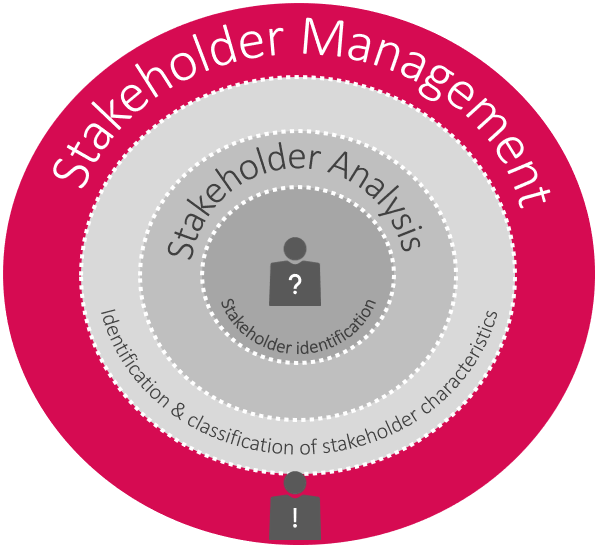
Hence, in this article, we see stakeholder management as a subdiscipline or a knowledge domain of project management.
Let us move on to stakeholder analysis.
Stakeholder Analysis Definition
The stakeholder analysis asks who the stakeholders in the project are (stakeholder identification). It proceeds to identify their characteristics, such as influence, claims and level of interest in the project. Thus, the stakeholder analysis is a subdomain of stakeholder management.
When conducting a stakeholder analysis, you additionally document the following:
- Needs
- Requirements
- Wants
- Expectations
- Fears
This document will help you derive the project requirements. That is what makes the stakeholder analysis so central. If it does not take place, or is not completed, important project requirements may be overlooked.
In such a case, you may find stakeholders you never knew existed speak up during project execution – typically not a pleasant situation.
Things can get really unpleasant if stakeholders feel ignored.
Special Download: 10 Vital PMO Success Factors (PDF file)
Please fill in the form.
* Required Fields | Data Protection
Tools and Methods for Stakeholder Analysis
If you limit the consideration of who the stakeholders in your project are to yourself and your team, the danger of forgetting somebody will be high.
To avoid overlooking any stakeholders, you had best approach it as follows:
Conduct a brainstorming session with people who are well-versed in the matter and / or in the project environment. If you plan it right, you can achieve good results with such a workshop.
How to Brainstorm for Stakeholder Analysis
Good brainstorming follows these 12 rules:
- There is a moderator but no leader
- Set a time limit and make sure that there are no interruptions during the workshop
- The topic of the session should unleash creativity and not restrain it
- Criticism and judgement of the ideas is not desired
- Neither are irritated noises, grimaces or laughter
- Ideas are not discussed
- The quantity of ideas counts (reverse the thought of ‘quality over quantity’)
- Radical and strange ideas are welcome
- Each idea is taken down
- The notes remain unstructured
- The participants of the session should build on each other’s ideas
- A selection only takes place after brainstorming
If you invite the right people and manage to stick to these rules, you should end up with a comprehensive collection of stakeholders and their most important characteristics.
Our tip: Are there introverted people on your team or among the experts you are consulting? Are there some people who dominate the discussion and intimidate others? If so, use a technique for brainstorming that ensures that all voices are heard. The Nominal Group Technique which we describe in our article on Risk Management in Project Management.
If you follow the 12 rules for good brainstorming, you will be able to gather a multitude of important and unstructured contributions regarding the stakeholders in your project.
Now you have an unsorted collection of names and important points on your project stakeholders. What could you do to get this list into a structured and presentable format?
It makes sense to use an affinity diagram.
The kick-off workshop also benefits stakeholders and overall project success.
Affinity Diagram for Stakeholder Classification
Create your affinity diagram in three steps:
- Brainstorming (this you have already done)
- Find and name suitable groups
- Assign your stakeholders to the groups
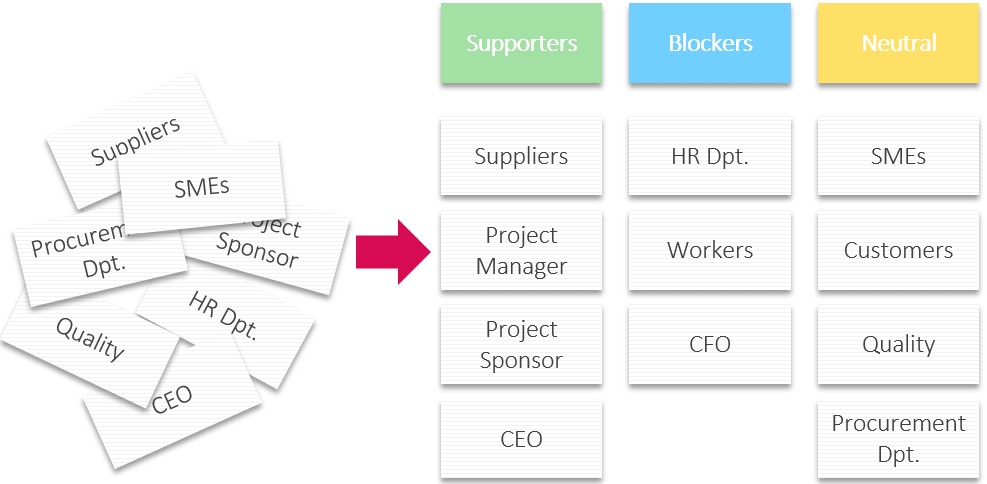
An evaluative assignment can of course have a certain political significance. You should consider carefully how you present such a diagram and, above all, to whom. When used within a project team, it can serve to clarify strategies against resistance.
Clear communication rules help in case of doubt.
Matrix for Assigning Responsibilities
Clear communication rules will facilitate awareness in your team. For the collaboration in the project, they will become familiar with the diverse stakeholders’:
- Contact person
- Claims
- Requirements
For this purpose, you can draw up an overview outlining who is responsible for what; and when they should be informed about what.
The below matrix for assigning responsibilities is a good example of this.
A Responsibility Assignment Matrix (RAM), aka RACI Matrix, shows which stakeholder is authorized or responsible for what. In addition, it outlines whom to consult or inform on what topic. The following graphic presents an RAM / RACI matrix.
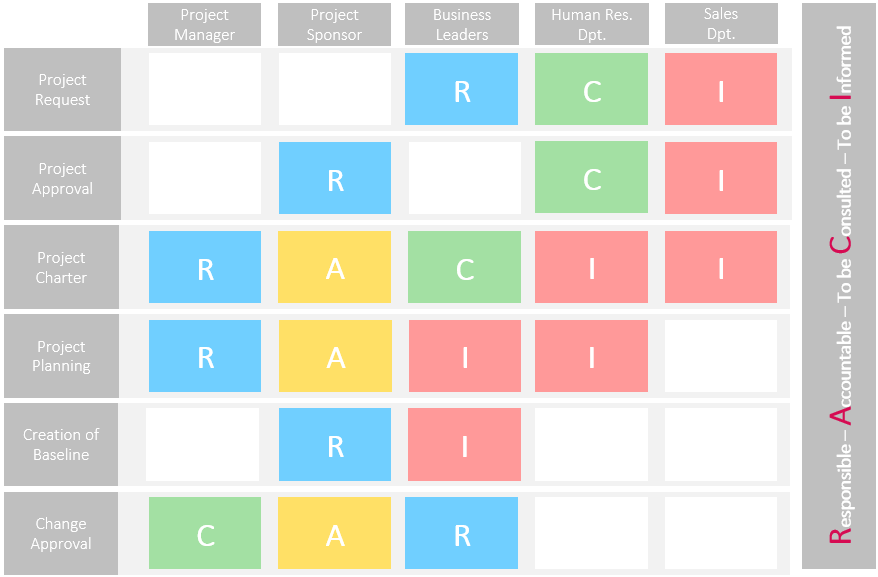
No matter whether you follow agile, traditional or hybrid methods in your project – fundamentally, you will wish to promote open and transparent collaboration with your stakeholders and build a relationship of trust, if possible.
Our tip: Use different proven methods of visualization to create a clear communication structure. This ensures that the right people will be informed about things they need to know; thus, it fosters the smooth collaboration within your project.
How to Draw Up Your Stakeholder List
One thing that will help with stakeholder management in any case is a detailed list of all stakeholders. It should contain all important information, such as:
- Position at the company
- Role of the stakeholder in the project
- Needs
- Wants
- Expectations
- Project requirements
- Priority
- Issues
- Project tasks (with named assignment)
Find an example of one such list below.
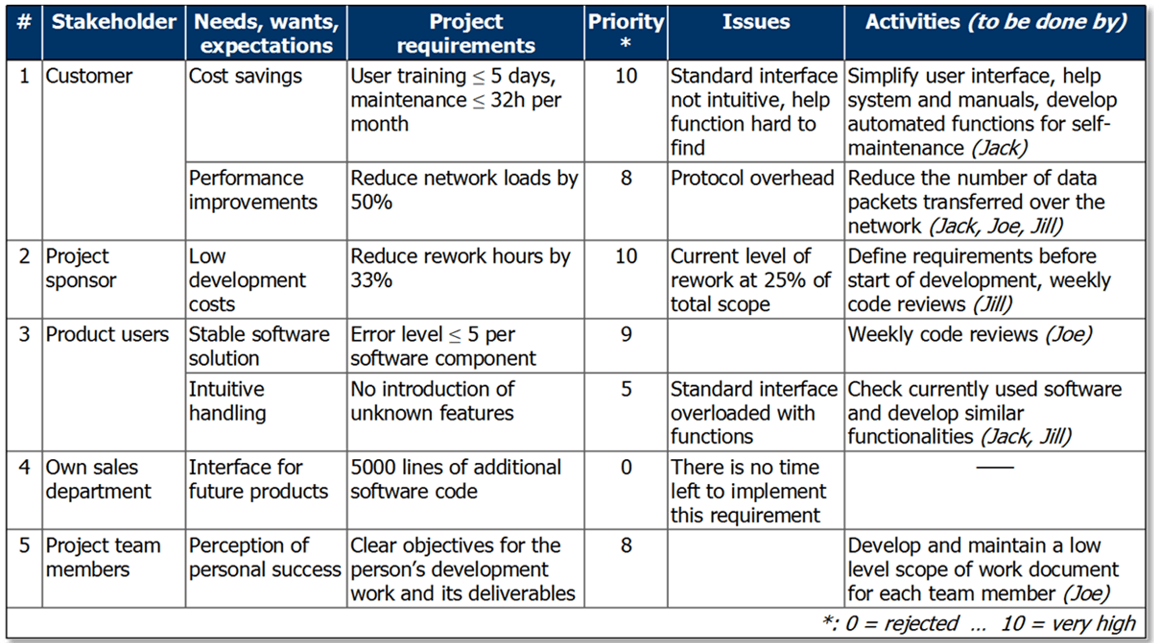
So far, you have identified many stakeholders for your project and defined them in detail. Now you ask yourself the following question: what really matters when dealing with them?
Proper Interaction with Stakeholders
This is where your soft skills come in. Hardly any other task in project management (apart from team management) places as great demands on interpersonal skills as the right interaction with the stakeholders.
You should be able to:
- Understand the attitude and personality of the stakeholders
- Respect confidentiality
- Maintain your integrity
- Network actively
- Set the right tone
- Lead others without appearing to be bossy
If you can do all this, you are in a good position to manage the expectations of your stakeholders.
Please note: It is not your task is not to “manage” the stakeholders as individuals. You have to actively take care of your stakeholders’ commitment to the project and their expectations.
Stakeholder Management Examples
No project in the world will manage to fulfill all expectations. You may know this, for example in cases where a team that is already very busy is confronted with ever-new change requests. A no or an alternative offer to stakeholders can be unavoidable at times for that reason only.
Please note: It is never possible to fulfil all wishes. This means you have to be able to say no at times or consider alternatives.
However, to be able to decide this effectively, your initial job is to listen attentively and to understand. When consulting your stakeholders, you should know which questions you are going to ask and to whom you are asking them.
This is aggravated by the fact that stakeholders are often unable to express their expectations in a comprehensible way. Sometimes, they do not even know themselves what they want exactly. In such a case, you need to make suggestions that might help them along.
What is more, expectations are often influenced by people who are outside your sphere of influence. Here are two possible scenarios:
- If a head of department constantly expects new functions in your software, the reason for this may be pressure from the next higher management level.
- Is there a stakeholder whose wishes are completely opposed to those of another? In this case, the difficult task is to make well-balanced decisions and to communicate them actively.
The agile project management environment provides an interesting method for visualizing different stakeholder groups.
Make Use of Personas
Personas are profiles of typical members of user groups. They do not have to correspond to real existing individuals; they should merely represent them. This allows the team to better identify the stakeholders and engage with them.
This technique is popular among software development teams. As a result, the team members are less likely to lose sight of the people for whom they are ultimately doing their work.
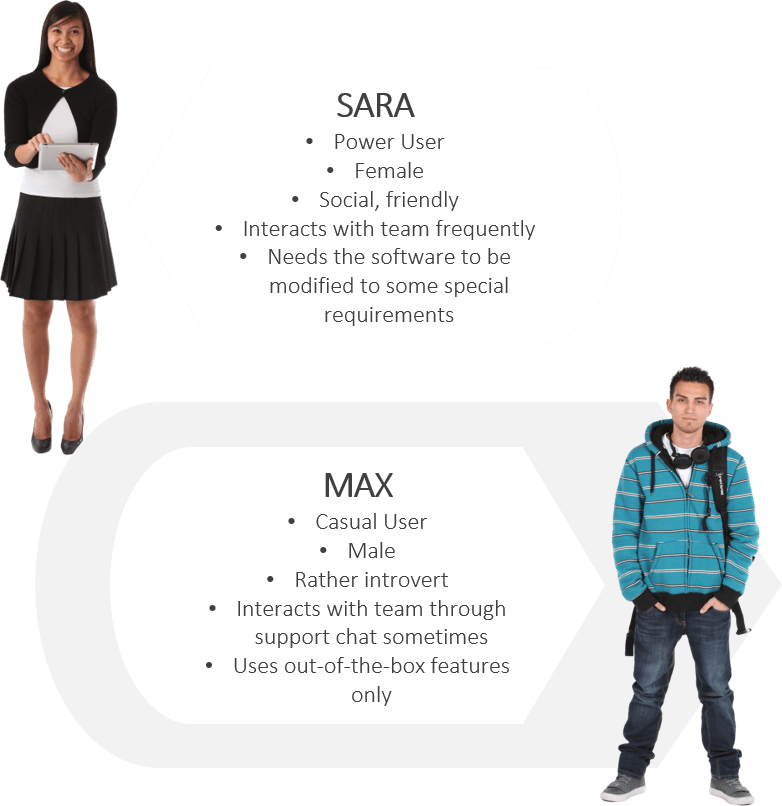
What is exciting: just by creating the personas, you can unleash creative processes and generate ideas for new solutions.
Our tip: Use the persona approach for better visualization. Every now and then, a team should check whether the personas are still up to date and revise them if necessary.
Force Field Analysis
Some projects are faced with the challenge of bringing about major changes. Not all stakeholders will be welcoming these.
If this is what you encounter, your project team might find it difficult to continue working effectively against high levels of resistance.
There is rarely a simple solution to such situations.
This is where methods such as active change management or even acceptance management are necessary. Of course, it is always important to understand the reservations – usually, they are there for a reason.
With the force field analysis, Kurt Lewin (1890-1947) developed a visual depiction juxtapoising driving and restraining forces. This makes it possible to evaluate the probability of a successful change.
In this context, driving forces represent the initiation or support of a change. Examples of this could be:
- Order from a superior
- Advantages and incentives
- Competitive pressure
- Stakeholders actively advocating the change
Restraining forces, on the other hand, is the term for resistance slowing down or preventing a change. They can manifest themselves as:
- Apathy or aggression in people who are against it
- Technical problems
- Difficulties in communication
- Stakeholders who want to prevent change
The force field analysis assigns values to these attitudes on a spectrum in both directions and then calculates the average. The following figure shows an example of this.
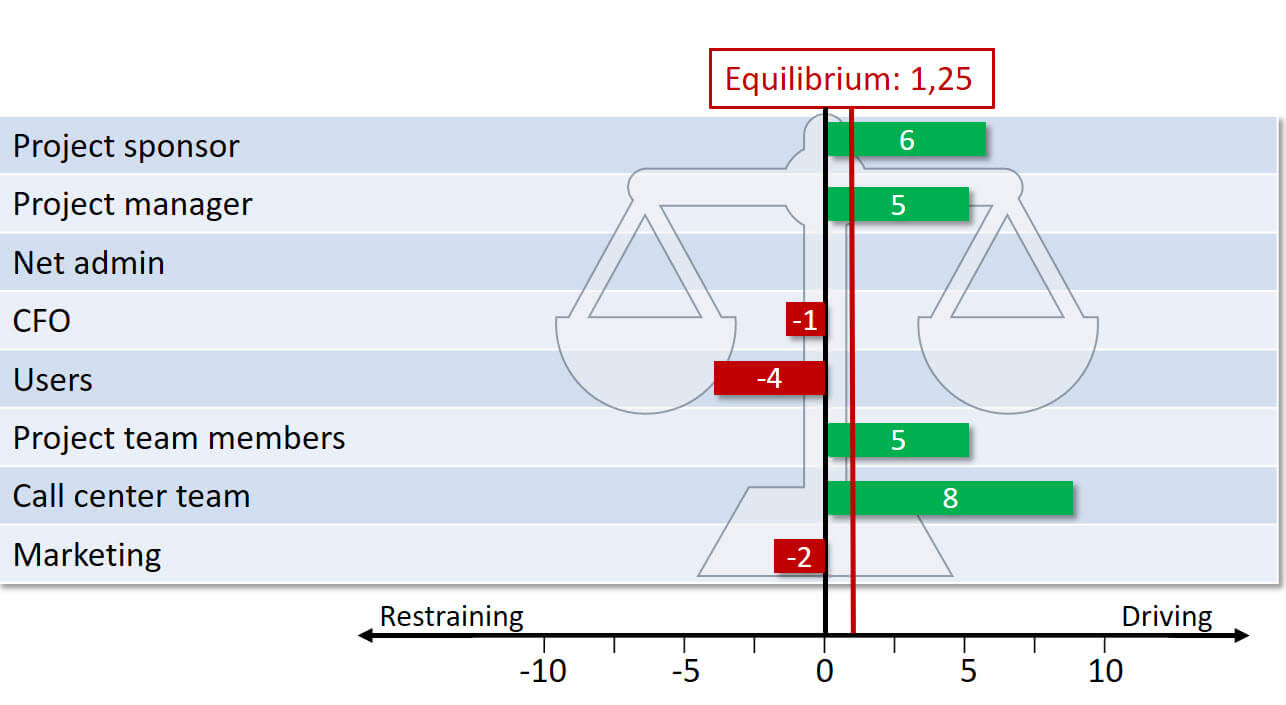
How to Manage Stakeholders in Agile Projects
In the agile world, active stakeholder involvement is firmly established and even more important for project success than in traditional and more forward-planning project management.
Agile projects tend to have a high level of uncertainty which is why they need the following:
- Mutual trust and cooperation
- A common project vision and goals
- Room for stakeholders to contribute and show initiative
- Transparency and openness as key values
- Frequent interaction with stakeholders
For the last item in the list, most agile methods and frameworks have concrete specifications.
Scrum provides for a review of the deliverable intermediate results after each work interval (Sprint), together with the stakeholders. During this meeting, the latter can and must actively contribute their feedback. Thus, they help decide on the further course of the project.
In Extreme Programming, there is the principle of the customer on site. In this scenario, the customer or a representative and the team permanently work on the results together on site – or at least the customer has a say in them.
Not least because the Agile Manifesto requires “customer collaboration over contract negotiation”. This is a confident demonstration of the credo that even issues that are important in principle, such as contract negotiation, should never stand in the way of successful collaboration with stakeholders in the project.
Suggested reading: Agile, traditional or hybrid? When to use which method.
Conclusion – Stakeholder Management and Analysis in Projects
This article has introduced you to the meaning of the terms stakeholder, stakeholder analysis and stakeholder management and their relation to each other.
- Now, you know why active stakeholder management regarding their expectations and needs is so important.
- You have learnt about different methods of stakeholder analysis and the collaboration with the stakeholders.
- Plus, you have found out about the special meaning of close collaboration with your stakeholders in agile projects.
You now have a number of methods and tools at your disposal. They will allow you to better engage stakeholders in your projects and to balance their wishes with the project goals.
This will improve communication and thus the success of your future projects.
Our final tips:
Get to know the individually adaptable “PPM Paradise” – the optimal environment for your enterprise-wide project, program, portfolio and resource management (PPM). Download the free eBook “The PPM Paradise” now (just click, no form).
And sign up for our bi-weekly blog newsletter with information on more practical articles, eBooks, etc. to improve your project management maturity level.
What has been your experience in this field? Do you feel we missed an important point, and is there anything you would like to add to this article? Write a short comment now.
Subscribe to TPG BlogInfo: Never miss new practice-oriented tips & tricks
Every other week: Receive practical tips in TPG blog posts written by recognized experts in project, portfolio, and resource management.
* Required Fields | Data Protection
About the author:Antje Lehmann-Benz, PMP, PMI-ACP, PSM expert is a trainer for project management with a particular focus on agile practices and Scrum seminars. Furthermore, she has experience as a software trainer (JIRA, Confluence) and consultant. In addition to teaching frameworks and theory, she is experienced in the use of agile games and practical exercises to reinforce the knowledge gained.
Read more about Antje Lehmann-Benz on Linkedin.


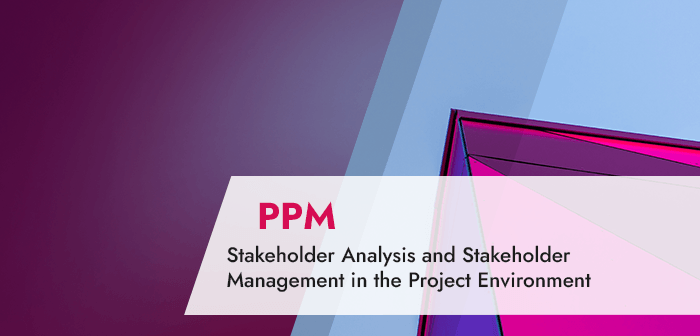





4 Comments
Really loved this article – so much to take away, thank you! 🙂
Thank you so much, Cate. We’re happy to hear that!
I rarely take the time to save articles. This is one of the best I have ever read on Stakeholder Management and will definitely be shared with my team. Thank you for sharing your knowledge.
Thanks, Jennifer. We’re happy to hear that.